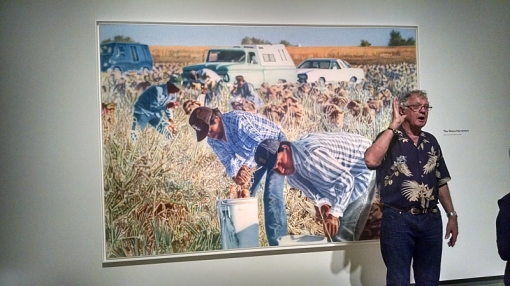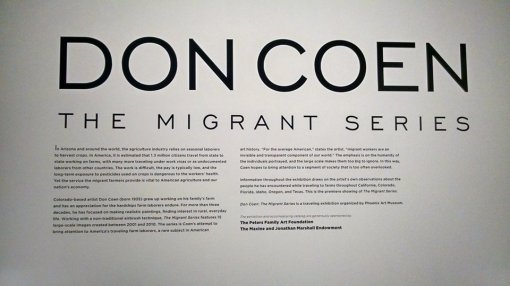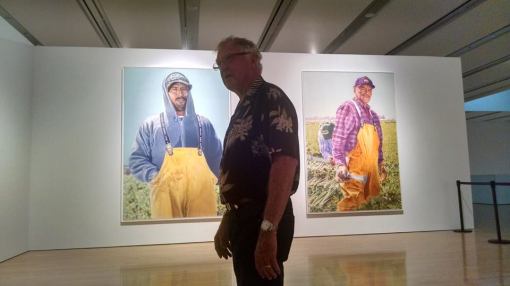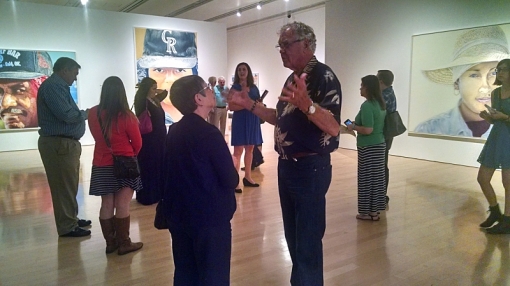
Artist Don Coen speaks before the opening of his “Migrant Series,” Phoenix Art Museum, Oct. 17, 2014.
An impressive show has launched at the Phoenix Art Museum that forces viewers to take a closer look at people and products they may take for granted. “The Migrant Series” by Don Coen is composed of arresting portraits of the migrant workers who bring much of the food to American tables. It opened on October 18 and runs through February 1, 2015.
Just a few days ago, I recommended an art-related event. I hadn’t planned to offer another so soon, but last night’s address by President Obama explaining his sweeping move to overhaul the nation’s immigration system got me thinking that this Change of Venue Friday should also head down the migrant path.
Understand, Don Coen’s remarkable artwork is not about undocumented workers or illegal immigration—though its appearance at the museum was affected by both of those things. Instead, his pieces are about the people themselves, most often workers who are here legally.
A media preview of the show on October 17 gave the opportunity to hear from the Colorado artist and some museum officials.
Ten years’ work went into the show, Coen said. And it was our relationship with our dining-room table that drove him.
“At Whole Foods, we pick up food, but we usually have no idea where it comes from,” Coen told attendees.
Perhaps best known for his previous work called the Lamar Series, Coen hopes viewers focus on the workers who bring that food to most Americans.
“I don’t think anyone will walk into the show and leave without knowing these people.”
Aiding in that result will be the near-photo-realism of the works, their close-up nature, and their massive scale.
Coen was accompanied at the media tour by his two grown sons. Shane Coen said, “Don saw the workers as friends, humans. He wanted to tell the human stories, show their faces.
Museum Director Jim Ballinger said how impressed he is by Coen’s work, including how its “luminosity is built up through layers of paint”—60 to 120 layers of paint per painting.
“This shows the back-of-the-house of the agricultural economy,” Ballinger told me. “America is so urban that we don’t see the agricultural life.”
That is the show’s most important layer, Ballinger said. When pressed, though, he did discuss the show in relation to the immigration debate.
He said that the museum delayed the show for a few years to avoid getting swept up in the debate over SB1070. “Don Coen’s first interest was not immigration,” Ballinger said. After all, most if not all of the people in the paintings are either citizens or have green cards.
But the topic cannot be entirely avoided, Ballinger acknowledged, and in the context of SB1070, there may be great value in helping people understand more about the individuals who work in the fields.
“It may change people’s minds about how we get the food that we get.”
Dr. Jerry Smith, curator of American and Western American Art at the museum, agreed.
“We didn’t want the heated debate of a few years ago to overwhelm the story” of Coen’s work, he said. “There are 1.3 million citizens who are migrant farmers; when those people can see themselves be self-represented, that’s good.”
Smith spoke with me about the paintings’ scale, “which is very important because it makes the point that you are looking at people who should not be ignored.”
“The takeaway is that you really don’t have to be a head of state to get a portrait.”
Son Shane Coen told me that the family originally wasn’t sure the project was a great idea—or how it would be received.
“In the beginning, we asked him, ‘What are you painting?’”
Ultimately, though, he saw that his father was able to “bring the workers’ voices to light.”
“Hopefully, it will bring more compassion.”
Cord Coen saw the show’s importance in its ability to reveal “a world that is often invisible to us.”
More photos can be found on the Arizona Attorney Magazine Facebook page.
(In case you wondered (as I did), Cord explained how Don Coen worked with such massive canvases: Not (as I had guessed) via scaffold, but by having the pieces raised and lowered into a gap in the floor. That allows Coen to stand on the floor and have the piece ride up and down on a track.)
Here is some more background from the Phoenix Art Museum:
“Don Coen: The Migrant Series was organized by Phoenix Art Museum and opens there on October 18, 2014. The exhibition is comprised of a series of 15 large-scale, realistic portrait paintings of migrant farm laborers by the Colorado artist. The paintings are inspired by photographs of individuals that Coen took on farms across the U.S. over a decade. During the hundreds of hours he spent in the fields studying and taking photos of these farmers, Coen got to know each person’s story and it shows in these paintings. Over the past decade, he painted these works measuring almost 10 by 7 feet using dozens of layers of paint applied with a spray gun—then added the finishing details by hand with pencil. In these portrait paintings, the artist’s non-traditional approach of using airbrush is apparent.
Follow @azatty


November 21, 2014 at 12:23 pm
More photos can be found on the Arizona Attorney Magazine Facebook page: https://www.facebook.com/media/set/?set=a.10152872376983832.1073741857.101770188831&type=3